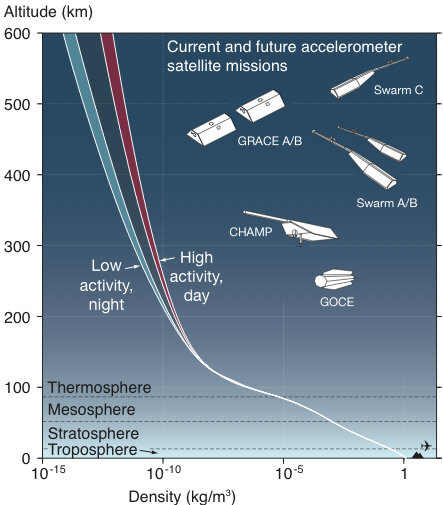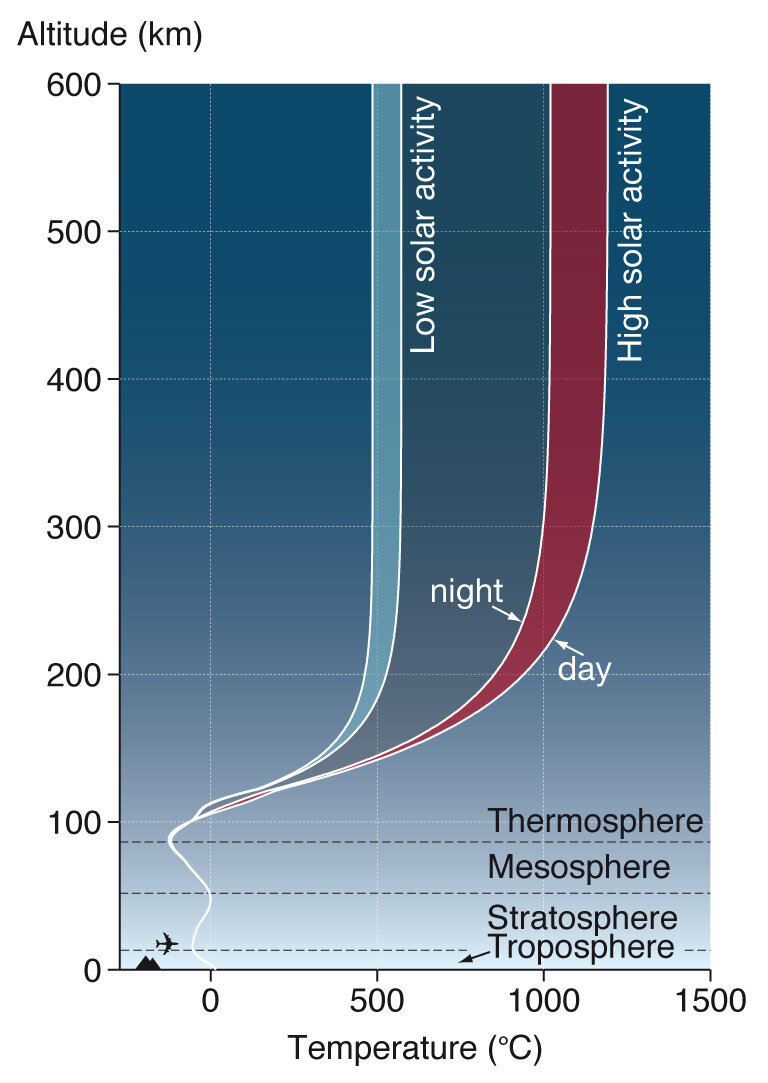ESA study paves the way for a better understanding of space weather
Earth observation satellites in low orbit are continually buffeted by the wisps of atmosphere that remain. Predicting how much air drag a satellite can encounter is critical to the design, cost and operation of a mission - an ESA study shows how.
Earth's atmosphere is often portrayed as a fragile, finite, thin layer of gas blanketing the planet. However, since the number of atmospheric particles decrease exponentially with altitude, there is no real boundary between the atmosphere and outer space. Even though the density of the air at satellite level is at least a billion times lower than at sea level, the speed at which satellites move in orbit is so high they can still experience drag.
Just like sailors and airline pilots have to account for the weather in the lower layers of the atmosphere – the troposphere and stratosphere, satellite operators have to be able to predict the weather in the upper regions of the atmosphere. Understanding air density is crucial when designing a mission, for example, air density and wind affect how much fuel is consumed and the lifetime of a satellite mission. In addition, knowing what the weather is like in space is important for planning manoeuvres, predicting re-entry and assessing the risk of collision.

The thermosphere starts at an altitude of around 90 km. This atmospheric layer is strongly influenced by ultraviolet radiation and charged particles originating from the Sun. It is also influenced by the magnetic and electric fields that surround Earth. The weather in the thermosphere is completely unlike that experienced on the ground. Winds can reach speeds of hundreds of metres per second and air density can vary by orders of magnitude, depending on the activity of the Sun.
The results of a recent study commissioned by ESA's General Studies Programme have shown that accelerometers, carried on current and future Earth observation satellites, can act as space weather observatories. These instruments measure acceleration relative to 'free fall' of an object in a near-circular orbit and can also provide valuable data to improve air density models. In contrast, ESA's gravity mission GOCE, which was launched into a very low orbit in March, has accelerometers that measure the drag the spacecraft is experiencing and ion thrusters for drag compensation.

The 18-month study was carried out by an international team led by the Delft University of Technology in the Netherlands and investigated accelerometer data from the German mission CHAMP and US-German mission GRACE. It also simulated data for ESA's Earth Explorer Swarm mission, which is due for launch in 2010. Swarm aims to improve our understanding of Earth's magnetic field including near-Earth current systems and their coupling with thermospheric density and winds.
Eelco Doornbos from the Delft University of Technology explained, "The study involved the cooperation of European experts in upper-atmospheric physics, satellite aerodynamics, orbital mechanics, modelling and data processing. We have investigated the most accurate way possible of deriving density and wind speeds from the accelerometer data, compared the results with existing models, created improvements to these models and have made recommendations for future satellite missions.”
Heiner Klinkrad of ESA's Space Debris Office summarised the merits of the present study, "The modelling of aerodynamic forces requires a good knowledge of all key parameters: the total air density, the effective aerodynamic cross-section, the velocity relative to a dynamic atmosphere, and the surface-molecule interaction parameters, of which the drag coefficient is the most important. The current study uses principles that were already developed at the beginning of space flight. The current accelerometer data, however, provide drag information that is several orders of magnitude better than in those days - both in absolute magnitudes and spatial/temporal resolution. Likewise, the molecule-surface interaction and the effective aerodynamic cross-section are known much better today, so we are able to extract very reliable information on the total density and aerodynamic velocity. I believe that the current study has significantly advanced research in this area."
The results of this important study have shown that air density and wind models can be significantly improved. This can help to reduce some of the current uncertainties involved in the complex tasks of planning, developing and operating satellites in low-Earth orbit.
For further information please contact:
Michael Kern
Study Technical Officer
ESA Mission Science Division
Tel: +31 71 5658720
Email: michael.kern @ esa.int
Andrés Gálvez
ESA General Studies Programme Manager
Tel: +33 1 5369 7623
Email: andres.galvez @ esa.int





